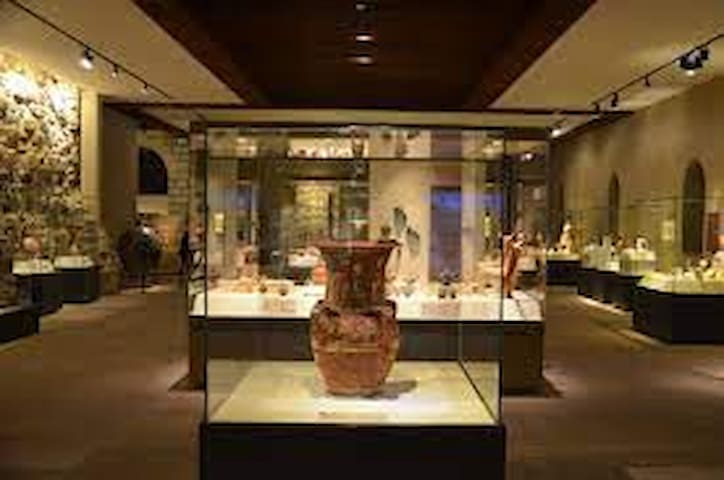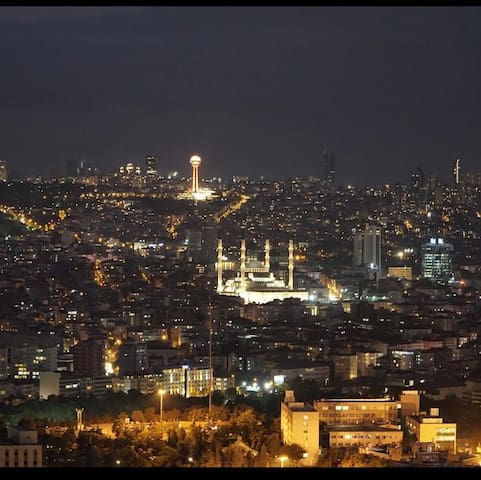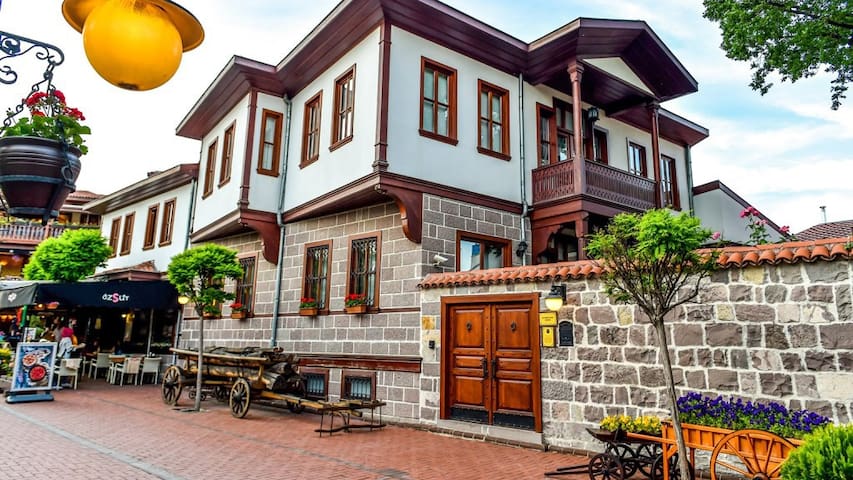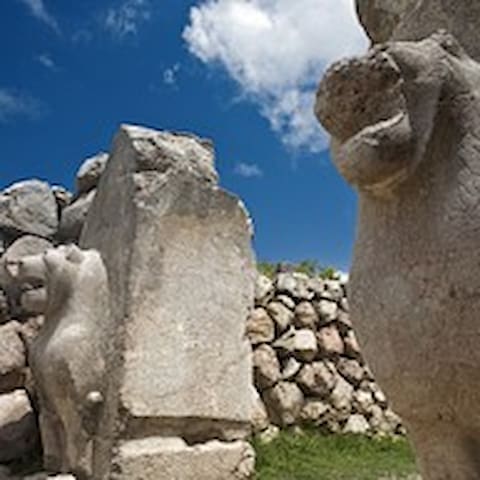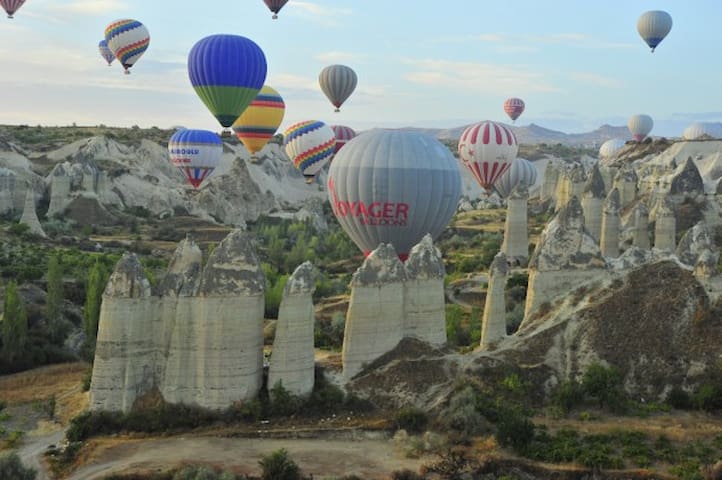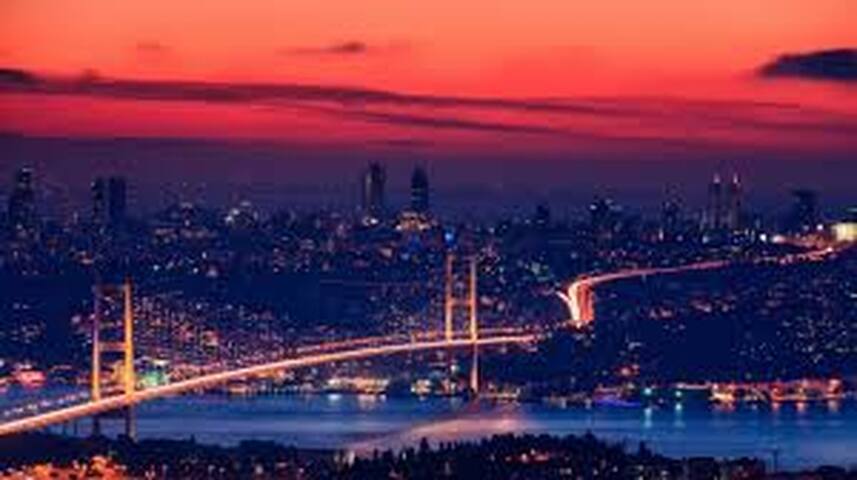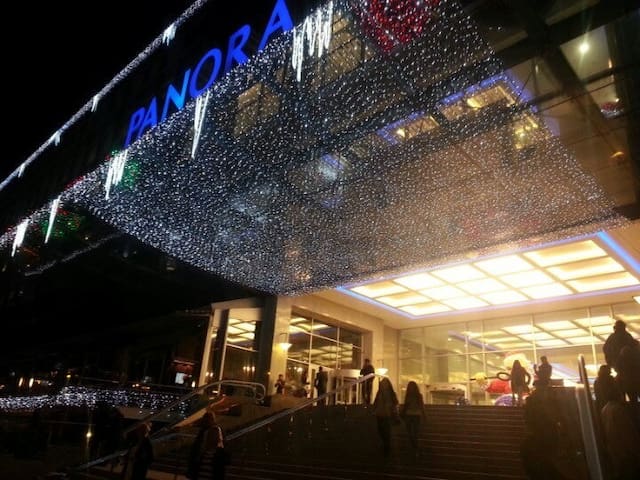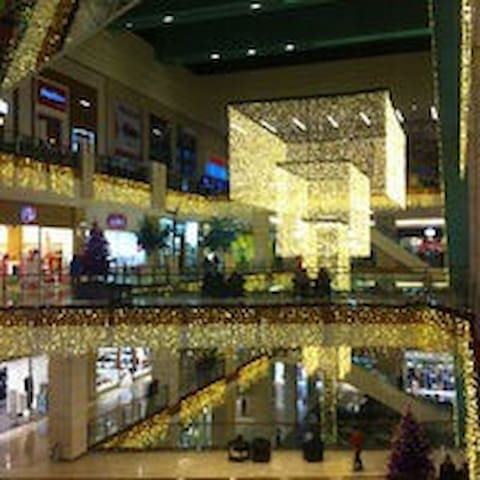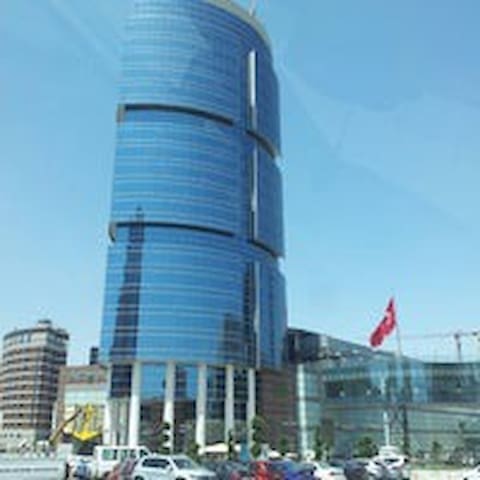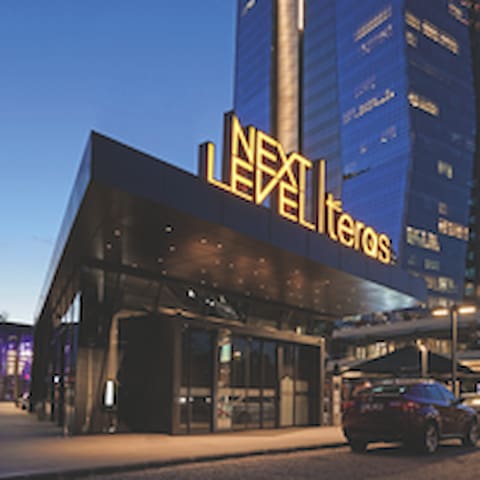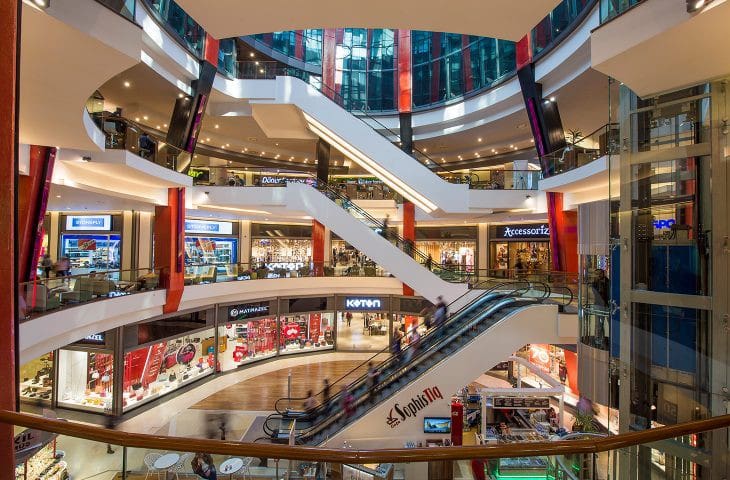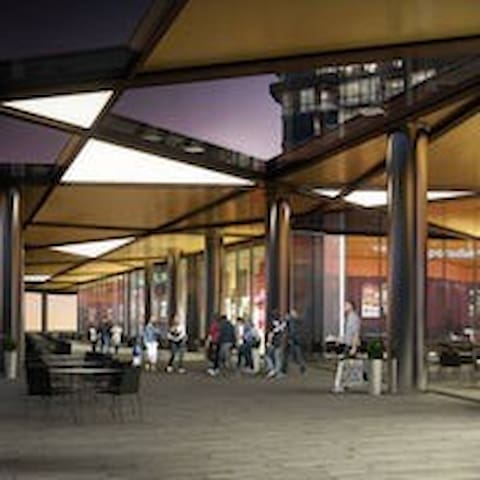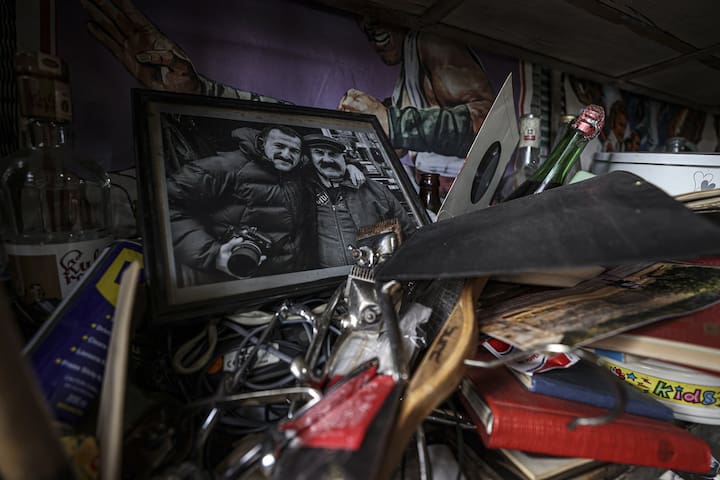Sightseeing
The only park at Ankara that you can lay on grass and sip your drink and have no worries about anything.Bring a mat or you will get wet! Come to watch sunset in July and August as it is mesmerising!
48 moradores locais recomendam
Parque Segmenler
The only park at Ankara that you can lay on grass and sip your drink and have no worries about anything.Bring a mat or you will get wet! Come to watch sunset in July and August as it is mesmerising!
Atakule, one of the oldest malls in Ankara, is perhaps the most notable landmark of the city. With its glorious 125-meter-long (410 feet) observation tower, it abuts and oversees the colorful Botanical Park of Ankara.
20 moradores locais recomendam
Atakule
AtakuleAtakule, one of the oldest malls in Ankara, is perhaps the most notable landmark of the city. With its glorious 125-meter-long (410 feet) observation tower, it abuts and oversees the colorful Botanical Park of Ankara.
Sengul Hammam was built in 15th century, restored in 19th century and completely renovates in 2009. It is located in the, the historic Jewish district, in Ulus, at the centre of old Ankara, in an area adjoining the south-west part of the citadel. Although İstiklal Mahallesi (Anafartalar Mh.) was known as Jewish district in the Ottoman period, it is not certain when the Jewish people were settled in this area.
Şengül Hamamı
No: 3 Acıçeşme Sk.Sengul Hammam was built in 15th century, restored in 19th century and completely renovates in 2009. It is located in the, the historic Jewish district, in Ulus, at the centre of old Ankara, in an area adjoining the south-west part of the citadel. Although İstiklal Mahallesi (Anafartalar Mh.) was known as Jewish district in the Ottoman period, it is not certain when the Jewish people were settled in this area.
Anıtkabir is the mausoleum of Mustafa Kemal Atatürk, the founder of the Republic of Turkey, also known as the “Father of the Turks”. Built on a vast area in the middle of central Ankara in 1952, Anıtkabir receives thousands of visitors every day. It is open every day between 9am – 4pm. Entrance is free.
The Anıtkabir complex comprises of 4 main sections: the Mausoleum (Hall of Honor), the Ceremony Square, the Lion Road and the Anıtkabir Museum of Atatürk.
Anıtkabir – photo by David Stanley
Atatürk’s tomb is located in an inaccessible underground chamber. However, you can visit the Hall of Honor where you will find Atatürk’s symbolic monumental tomb. This is the most important part of Anıtkabir.
To get to the Mausoleum and the Ceremony Square in front of it, you will have to walk past the Lion Road, a 262-meter-long road, adorned with 24 lion statues on both sides representing the old Turkic tribes. The Ceremony Square is a vast area overlooked by the Mausoleum, where crowds of thousands gather to revere Ataturk on important national holidays.
Atatürk’s symbolic sarcaphogus in the Hall of Honor – photo by Volki16
The Anıtkabir Museum of Atatürk is a 3000-meter squares museum complex underneath the Hall of Honor and consists of 4 sections. In first section, Atatürk’s personal belongings are exhibited. In the second section, you will find oil paintings depicting scenes from the Gallipoli War and the Turkish War of Independence. The third section includes galleries and artworks giving information about the reforms and revolutions implemented during Atatürk’s era. The final section boasts a huge collection of Atatürk’s books (3123 books to be exact) and provides information about Atatürk’s life and the construction of Anıtkabir.
Ataturk & Independence War Museum
Anıt CaddesiAnıtkabir is the mausoleum of Mustafa Kemal Atatürk, the founder of the Republic of Turkey, also known as the “Father of the Turks”. Built on a vast area in the middle of central Ankara in 1952, Anıtkabir receives thousands of visitors every day. It is open every day between 9am – 4pm. Entrance is free.
The Anıtkabir complex comprises of 4 main sections: the Mausoleum (Hall of Honor), the Ceremony Square, the Lion Road and the Anıtkabir Museum of Atatürk.
Anıtkabir – photo by David Stanley
Atatürk’s tomb is located in an inaccessible underground chamber. However, you can visit the Hall of Honor where you will find Atatürk’s symbolic monumental tomb. This is the most important part of Anıtkabir.
To get to the Mausoleum and the Ceremony Square in front of it, you will have to walk past the Lion Road, a 262-meter-long road, adorned with 24 lion statues on both sides representing the old Turkic tribes. The Ceremony Square is a vast area overlooked by the Mausoleum, where crowds of thousands gather to revere Ataturk on important national holidays.
Atatürk’s symbolic sarcaphogus in the Hall of Honor – photo by Volki16
The Anıtkabir Museum of Atatürk is a 3000-meter squares museum complex underneath the Hall of Honor and consists of 4 sections. In first section, Atatürk’s personal belongings are exhibited. In the second section, you will find oil paintings depicting scenes from the Gallipoli War and the Turkish War of Independence. The third section includes galleries and artworks giving information about the reforms and revolutions implemented during Atatürk’s era. The final section boasts a huge collection of Atatürk’s books (3123 books to be exact) and provides information about Atatürk’s life and the construction of Anıtkabir.
It is not known when and by whom the citadel was built. The Ankara Citadel carries the markings of the ancient residents of Anatolia, such as the Hittites, Galatians, Phrygians, Romans, Byzantines, Seljuks and Ottomans. In 1832, the citadel took its final form after a restoration that was funded by Ibrahim Pasha, the son of the Ottoman Governor to Egypt, Mehmed Ali Pasha. During the restoration, many marble blocks were acquired from the surrounding Roman sites and, today, it is possible to see stone building blocks embedded into the castle walls with inscriptions in Latin carved into them.
Ankara Citadel – photo by Bernard Gagnon
The alleys within the citadel and around it are full of small shops where you can find a wide range of goods such as spices, copper artisanal works, as well as handicraft workshops and fine examples of carpentry works.
You’ll also find many cozy cafes and coffeeshops around the citadel, where you can try out the local specialties or relieve your fatigue with various beverages.
Considered to be the prime touristic site of the city, the Ankara Citadel beholds many attractions around it. The most notable spots visitors should see are the Rahmi Koç Museum, the Erimtan Archeology Museum and the Anatolian Civilizations Museum.
58 moradores locais recomendam
Castelo de Ancara
It is not known when and by whom the citadel was built. The Ankara Citadel carries the markings of the ancient residents of Anatolia, such as the Hittites, Galatians, Phrygians, Romans, Byzantines, Seljuks and Ottomans. In 1832, the citadel took its final form after a restoration that was funded by Ibrahim Pasha, the son of the Ottoman Governor to Egypt, Mehmed Ali Pasha. During the restoration, many marble blocks were acquired from the surrounding Roman sites and, today, it is possible to see stone building blocks embedded into the castle walls with inscriptions in Latin carved into them.
Ankara Citadel – photo by Bernard Gagnon
The alleys within the citadel and around it are full of small shops where you can find a wide range of goods such as spices, copper artisanal works, as well as handicraft workshops and fine examples of carpentry works.
You’ll also find many cozy cafes and coffeeshops around the citadel, where you can try out the local specialties or relieve your fatigue with various beverages.
Considered to be the prime touristic site of the city, the Ankara Citadel beholds many attractions around it. The most notable spots visitors should see are the Rahmi Koç Museum, the Erimtan Archeology Museum and the Anatolian Civilizations Museum.
The Rahmi Koç Museum is made up of two historical structures: Çengelhan, an old inn remaining from Suleiman the Magnificent’s era, and Safrahan, a 16th century caravanserai. It is a technology and industry museum built in 2005 by the Koç family, the wealthiest and most influential family of Turkey. Around 4 thousand objects are being displayed in the museum, giving a comprehensive insight into the industrial history of both and Turkey and the world. The 30 galleries of the museum boast a wide range of collections of marine technologies, products and methods used in pharmaceutical industries, agricultural machines, aviation equipment, olden transportation vehicles, rail transportation items, toys, and instruments for communications, science, maritime navigation, and much more. Moreover, there are also galleries about Atatürk and Vehbi Koç, the founding father of the Koç family, who was one of the first industrialists and businessmen in Turkey. In addition, there is a nice café where you can get some rest and taste delicious specialties. The entrance fee for the Rahmi Koç Museum is 15 liras for adults and 10 liras for students. Note that the museum is closed on Mondays. On weekdays and weekends, you can visit the museum between 11am – 5pm.
The Rahmi Koç Museum – photo taken from hurriyet.com
The Erimtan Archeology Museum was founded by Turkish businessman, Yüksel Erimtan. In 2015, three old houses near the Ankara Citadel were restored and turned into the museum building where many objects in Yüksel Erimtan’s personal collection of Hittite, Urartu, Roman and Byzantine artifacts are now displayed in contemporary ways. The entrance fee is 12 liras for adults and 7 liras for students. Visiting hours are the same as for the Rahmi Koç Museum.
7 moradores locais recomendam
Museu Rahmi M. Koc Ankara
No:1 Depo SokakThe Rahmi Koç Museum is made up of two historical structures: Çengelhan, an old inn remaining from Suleiman the Magnificent’s era, and Safrahan, a 16th century caravanserai. It is a technology and industry museum built in 2005 by the Koç family, the wealthiest and most influential family of Turkey. Around 4 thousand objects are being displayed in the museum, giving a comprehensive insight into the industrial history of both and Turkey and the world. The 30 galleries of the museum boast a wide range of collections of marine technologies, products and methods used in pharmaceutical industries, agricultural machines, aviation equipment, olden transportation vehicles, rail transportation items, toys, and instruments for communications, science, maritime navigation, and much more. Moreover, there are also galleries about Atatürk and Vehbi Koç, the founding father of the Koç family, who was one of the first industrialists and businessmen in Turkey. In addition, there is a nice café where you can get some rest and taste delicious specialties. The entrance fee for the Rahmi Koç Museum is 15 liras for adults and 10 liras for students. Note that the museum is closed on Mondays. On weekdays and weekends, you can visit the museum between 11am – 5pm.
The Rahmi Koç Museum – photo taken from hurriyet.com
The Erimtan Archeology Museum was founded by Turkish businessman, Yüksel Erimtan. In 2015, three old houses near the Ankara Citadel were restored and turned into the museum building where many objects in Yüksel Erimtan’s personal collection of Hittite, Urartu, Roman and Byzantine artifacts are now displayed in contemporary ways. The entrance fee is 12 liras for adults and 7 liras for students. Visiting hours are the same as for the Rahmi Koç Museum.
Undoubtedly, the most popular museum in Ankara, Anatolian Civilizations Museum, boasts a vast collection of artefacts unearthed in Anatolia carrying marks of various civilizations.
The museum has sections focused on the Paleolithic Age, Chalcolithic Age, Old Bronze Age, Assyrian Trade Colonies, Old Hittite and Hittite Imperial Ages, the Phrygian Kingdom, the Late Hittite Kingdom, the Urartian Kingdom, and Classical Periods.
An ancient well-preserved text – photo by Bjørn Christian Tørrissen / A statue head – photo by Georges Jansoone
Given the award for “Museum of the year in Europe” in 1997, the Anatolian Civilizations Museum is a must-see site in Ankara.
Entrance for the museum costs 45 liras and is free with a Museum Card. The museum can be visited between 10am-5pm during the summer period (1 April-1 November) and between 8.30am-6pm during the winter period (1 November-1 April).
36 moradores locais recomendam
Museu das Civilizações da Anatólia
2 Gözcü Sk.Undoubtedly, the most popular museum in Ankara, Anatolian Civilizations Museum, boasts a vast collection of artefacts unearthed in Anatolia carrying marks of various civilizations.
The museum has sections focused on the Paleolithic Age, Chalcolithic Age, Old Bronze Age, Assyrian Trade Colonies, Old Hittite and Hittite Imperial Ages, the Phrygian Kingdom, the Late Hittite Kingdom, the Urartian Kingdom, and Classical Periods.
An ancient well-preserved text – photo by Bjørn Christian Tørrissen / A statue head – photo by Georges Jansoone
Given the award for “Museum of the year in Europe” in 1997, the Anatolian Civilizations Museum is a must-see site in Ankara.
Entrance for the museum costs 45 liras and is free with a Museum Card. The museum can be visited between 10am-5pm during the summer period (1 April-1 November) and between 8.30am-6pm during the winter period (1 November-1 April).
The Ankara Roman Bath is a 3rd century BC bath complex built by the Roman Emperor Caracalla in honor of the God of Medicine and Health, Asclepius. It is spread over a vast ground in the central district of Ulus.
The Roman Bath complex, covering an area of approximately 65,000 m2, is an open-air museum where you will find around 1000 stoneworks, including tomb steles, tablets and architectural pieces, that are scattered among the ruins. These stoneworks chiefly date back to the Roman and Byzantine times.
The site can be visited between 10am-7pm in the summer period (1 April-1 November) and between 8.30am-5pm in the winter period (1 November-1 April). The entrance is 10 liras, or free with a Museum Card.
6 moradores locais recomendam
Banho Romano
No:43 Çankırı Cd.The Ankara Roman Bath is a 3rd century BC bath complex built by the Roman Emperor Caracalla in honor of the God of Medicine and Health, Asclepius. It is spread over a vast ground in the central district of Ulus.
The Roman Bath complex, covering an area of approximately 65,000 m2, is an open-air museum where you will find around 1000 stoneworks, including tomb steles, tablets and architectural pieces, that are scattered among the ruins. These stoneworks chiefly date back to the Roman and Byzantine times.
The site can be visited between 10am-7pm in the summer period (1 April-1 November) and between 8.30am-5pm in the winter period (1 November-1 April). The entrance is 10 liras, or free with a Museum Card.
Hacı Bayram Veli Mosque, built in 1427, is one of the most prominent religious structures in Ankara.
It was devoted to Hacı Bayram Veli, who was an important personality in Islam and a respected Muslim scholar. Maintained and restored with abundant care throughout the centuries, the interior of the Hacı Bayram Veli Mosque is adorned with the finest examples of traditional Kütahya china artworks.
The entrance to the Hacı Bayram Veli Mosque
Inside the mosque – photo A. F. Aytekin
Right alongside the Hacı Bayram Veli Mosque, you will find the ancient temple of Augustus, which is the most intact remnant of the Roman period in Ankara. Built on top of an ancient Phrygian temple which was devoted to the Phrygian Goddess Kybele (Mother of Gods) and God Men (God of Moon), this 1st century BC temple was constructed during the Emperor Augustus’ rule.
During excavations, many important findings have been unearthed. An epigraph titled Res Gestae Divi Augusti (Augustus’ Deeds), written in Latin and Ancient Greek about the life and achievements of the emperor, was found on the walls of the temple.
Today, the temple stands well-preserved and receives thousands of visitors every day. There is no regulated visiting hour, so it is open to visitors 24/7. However, the temple is protected with glass fences, so it is only possible to walk around it and observe the temple from behind the fences.
Temple of Augustus
Hacı Bayram Veli Mosque, built in 1427, is one of the most prominent religious structures in Ankara.
It was devoted to Hacı Bayram Veli, who was an important personality in Islam and a respected Muslim scholar. Maintained and restored with abundant care throughout the centuries, the interior of the Hacı Bayram Veli Mosque is adorned with the finest examples of traditional Kütahya china artworks.
The entrance to the Hacı Bayram Veli Mosque
Inside the mosque – photo A. F. Aytekin
Right alongside the Hacı Bayram Veli Mosque, you will find the ancient temple of Augustus, which is the most intact remnant of the Roman period in Ankara. Built on top of an ancient Phrygian temple which was devoted to the Phrygian Goddess Kybele (Mother of Gods) and God Men (God of Moon), this 1st century BC temple was constructed during the Emperor Augustus’ rule.
During excavations, many important findings have been unearthed. An epigraph titled Res Gestae Divi Augusti (Augustus’ Deeds), written in Latin and Ancient Greek about the life and achievements of the emperor, was found on the walls of the temple.
Today, the temple stands well-preserved and receives thousands of visitors every day. There is no regulated visiting hour, so it is open to visitors 24/7. However, the temple is protected with glass fences, so it is only possible to walk around it and observe the temple from behind the fences.
Kızılay is the heart of Ankara, therefore of Turkey as well, and is the liveliest area of the city. Kızılay does not boast a specific attraction nor any historical sites. However, it is indisputably the best place to get a good picture of the daily life in Ankara and to see how people go about their days. The streets and alleys of Kızılay are full of shops, where you will find pretty much everything for reasonable prices, and countless cafes and restaurants. I highly recommend you to explore Kızılay thoroughly and get absorbed into the busy and colorful metropolitan life of Ankara.
17 moradores locais recomendam
Kızılay
Kızılay is the heart of Ankara, therefore of Turkey as well, and is the liveliest area of the city. Kızılay does not boast a specific attraction nor any historical sites. However, it is indisputably the best place to get a good picture of the daily life in Ankara and to see how people go about their days. The streets and alleys of Kızılay are full of shops, where you will find pretty much everything for reasonable prices, and countless cafes and restaurants. I highly recommend you to explore Kızılay thoroughly and get absorbed into the busy and colorful metropolitan life of Ankara.
Kuğulu Park (Swan Park) is a 1 ha (2.5 acres) public park in the Çankaya neighborhood of Ankara, Turkey. The park is known for its swans (a symbol of Ankara), but also has ducks and geese. Its pond was renovated in 2012.
In June 2013 Kuğulu's waterfowl (35 birds) were evacuated temporarily to protect them from tear gas exposure during the 2013 Turkish protests. The park was a major meeting point for protestors, and saw a Taksim Gezi Park-style encampment.
The City of Vienna gave the park a gift of swans.
48 moradores locais recomendam
Kuğulu Park
Kuğulu Park (Swan Park) is a 1 ha (2.5 acres) public park in the Çankaya neighborhood of Ankara, Turkey. The park is known for its swans (a symbol of Ankara), but also has ducks and geese. Its pond was renovated in 2012.
In June 2013 Kuğulu's waterfowl (35 birds) were evacuated temporarily to protect them from tear gas exposure during the 2013 Turkish protests. The park was a major meeting point for protestors, and saw a Taksim Gezi Park-style encampment.
The City of Vienna gave the park a gift of swans.
It is the Turkey’s biggest Shopping Mall aquarium with a 105 meter-long tunnel aquarium, thematic aquarium tanks with more than 20 different themes and in different sizes, touch pools, a cafeteria, photography points and a souvenir shop. In addition to the aquarium, Aqua Vega also includes a reptile house with poisonous and interesting exotic living creatures.
Aquário Aqua Vega
Doğukent BulvarıIt is the Turkey’s biggest Shopping Mall aquarium with a 105 meter-long tunnel aquarium, thematic aquarium tanks with more than 20 different themes and in different sizes, touch pools, a cafeteria, photography points and a souvenir shop. In addition to the aquarium, Aqua Vega also includes a reptile house with poisonous and interesting exotic living creatures.
Ankara Botanical Garden: Understanding the World of Plants …
National Botanical Garden of Turkey, located 10 kilometers away from Ankara city center, covers an approximately 200 ha area on the kilometer 9 of the Ankara-Eskişehir highway. Located between two important university campuses, and a neighbor to two other universities, the National Botanical Garden occupies a strategic space in Ankara. The park has a dynamic topography defined with 150 meters in elevation difference from the north to the south. The area contains different habitats with slopes facing diverse orientations, natural valleys and two different waterscapes. The project area is divided into two zones: structures (entrance, visitor center, gathering area, thematic greenhouses, activity node, children’s playground and education area, dining area, activity lawn, picnic area, small and large lake, wetlands, research and development center for endemic plants, mass transportation stations and bridges) and gardens (regions of Turkey, countries, seasons, plant families, plants according to soil types, arboretum, steppe plants, existing orchards, thematic gardens and special plants). The circulation network consists of a main axis, as well as primary, secondary and tertiary roads, bicycle path, security lane and public transportation route.
Turkey's National Botanical Garden
6001 CaddesiAnkara Botanical Garden: Understanding the World of Plants …
National Botanical Garden of Turkey, located 10 kilometers away from Ankara city center, covers an approximately 200 ha area on the kilometer 9 of the Ankara-Eskişehir highway. Located between two important university campuses, and a neighbor to two other universities, the National Botanical Garden occupies a strategic space in Ankara. The park has a dynamic topography defined with 150 meters in elevation difference from the north to the south. The area contains different habitats with slopes facing diverse orientations, natural valleys and two different waterscapes. The project area is divided into two zones: structures (entrance, visitor center, gathering area, thematic greenhouses, activity node, children’s playground and education area, dining area, activity lawn, picnic area, small and large lake, wetlands, research and development center for endemic plants, mass transportation stations and bridges) and gardens (regions of Turkey, countries, seasons, plant families, plants according to soil types, arboretum, steppe plants, existing orchards, thematic gardens and special plants). The circulation network consists of a main axis, as well as primary, secondary and tertiary roads, bicycle path, security lane and public transportation route.
The State Art and Sculpture Museum (Turkish: Resim ve Heykel Müzesi) is a museum dedicated to fine arts and sculpture in Ankara, Turkey. It was designed in 1927 by architect Arif Hikmet Koyunoğlu and built between 1927 and 1930 as the Türkocağı Building, upon the direction of Mustafa Kemal Atatürk, the founder and first President of Turkey. It is located close to the Ethnography Museum and houses a rich collection of Turkish art from the late 19th century to the present day. There are also galleries for guest exhibitions.
The museum was reopened after the restoration of the building in 1980. Today, the museum is a center of art where the most outstanding works of the artists who played important roles in the development of Turkish painting and sculpture are exhibited. In addition to the collections of art works reflecting the formation and development periods of Turkish plastic arts, and its classification, and to the Library of Plastic Arts which fills the gap in this field (enriched every year by the donations of domestic or foreign resources, or by new purchases), the archives of Turkish artists satisfactorily respond to the needs of researchers working in these fields.
The protection of the works of fine arts, which is one of the most important responsibilities of the museum besides training, is done by employing a method particularly developed to ensure the most satisfactory results when dealing with the problems arising from temperature, humidity, and sorting difficulties. Any damage due to aging which may occur in spite of all protection measures is restored by experts in the special restoration unit which has been set up as a separate division within the museum.
During the restoration of the building in 1980, and in the following years, another important point on which considerable stress was laid in the construction of workshops of painting, sculpture, and ceramics, which serve artists, both amateur and professional. The museum was again restored in 2011 to increase the exhibition spaces, restore the roof as well as other security measures.
As for the security measures, the whole building is furnished with closed-circuit TV, ultrasonic and fire alarm systems for controlling all parts of the museum.
In addition to the workshop where painting and traditional printing courses are held (and demanded by the public beyond the capacity of the museum), special workshops for Turkish ornamental arts, ceramic, and sculpture will be opened in the near future.
Exhibitions of painting, sculpture, ceramic, printing arts, and photography that are programmed to take place in Turkey within the framework of international cultural agreements, are exhibited in the three galleries reserved for periodical exhibitions; thus, the artworks of foreign countries are made known to the Turkish public. In addition, exhibitions of Turkish artworks selected from the permanent collection of the museum are organized in foreign countries, within the framework of international cultural agreements. Besides these exhibitions, retrospective exhibitions organized by the General Directorate of Fine Arts; individual exhibitions, and competitive exhibitions are among the other activities of the museum.
In the historical hall which has been transformed to its original design during the restorations, different kinds of activities such as concerts, theatrical performances, and movie projections take place.
Serving the public with its modern cafeteria, sales outlet, and audio system, the institution goes beyond an exhibition place for old artwork; comprising all attributes of a modern museum of arts.
Museu de Pintura e Escultura de Ancara
Türkocağı SokakThe State Art and Sculpture Museum (Turkish: Resim ve Heykel Müzesi) is a museum dedicated to fine arts and sculpture in Ankara, Turkey. It was designed in 1927 by architect Arif Hikmet Koyunoğlu and built between 1927 and 1930 as the Türkocağı Building, upon the direction of Mustafa Kemal Atatürk, the founder and first President of Turkey. It is located close to the Ethnography Museum and houses a rich collection of Turkish art from the late 19th century to the present day. There are also galleries for guest exhibitions.
The museum was reopened after the restoration of the building in 1980. Today, the museum is a center of art where the most outstanding works of the artists who played important roles in the development of Turkish painting and sculpture are exhibited. In addition to the collections of art works reflecting the formation and development periods of Turkish plastic arts, and its classification, and to the Library of Plastic Arts which fills the gap in this field (enriched every year by the donations of domestic or foreign resources, or by new purchases), the archives of Turkish artists satisfactorily respond to the needs of researchers working in these fields.
The protection of the works of fine arts, which is one of the most important responsibilities of the museum besides training, is done by employing a method particularly developed to ensure the most satisfactory results when dealing with the problems arising from temperature, humidity, and sorting difficulties. Any damage due to aging which may occur in spite of all protection measures is restored by experts in the special restoration unit which has been set up as a separate division within the museum.
During the restoration of the building in 1980, and in the following years, another important point on which considerable stress was laid in the construction of workshops of painting, sculpture, and ceramics, which serve artists, both amateur and professional. The museum was again restored in 2011 to increase the exhibition spaces, restore the roof as well as other security measures.
As for the security measures, the whole building is furnished with closed-circuit TV, ultrasonic and fire alarm systems for controlling all parts of the museum.
In addition to the workshop where painting and traditional printing courses are held (and demanded by the public beyond the capacity of the museum), special workshops for Turkish ornamental arts, ceramic, and sculpture will be opened in the near future.
Exhibitions of painting, sculpture, ceramic, printing arts, and photography that are programmed to take place in Turkey within the framework of international cultural agreements, are exhibited in the three galleries reserved for periodical exhibitions; thus, the artworks of foreign countries are made known to the Turkish public. In addition, exhibitions of Turkish artworks selected from the permanent collection of the museum are organized in foreign countries, within the framework of international cultural agreements. Besides these exhibitions, retrospective exhibitions organized by the General Directorate of Fine Arts; individual exhibitions, and competitive exhibitions are among the other activities of the museum.
In the historical hall which has been transformed to its original design during the restorations, different kinds of activities such as concerts, theatrical performances, and movie projections take place.
Serving the public with its modern cafeteria, sales outlet, and audio system, the institution goes beyond an exhibition place for old artwork; comprising all attributes of a modern museum of arts.
Ankara is the capital city of the country of Turkey. It is in the center of Anatolia. Ankara is the second-largest city after Istanbul. The city has a population of 4,319,167 (2005) (Province 5,153,000), and an elevation of 938 meters (3080 feet). It was formerly known as Engürü the city is also the capital of Ankara Province
Ankara is a very modern city. Ankara was made the capital of Turkey in 1923. Ankara is known for its performing arts, home to the State Opera and Ballet, the Presidential Symphony Orchestra, and several national theater companies. In Ankara, there’s a place called Anitkabir, which is a big hilltop mausoleum that was built to celebrate Kemal Atatürk who was the first president.
History
Ankara is a city that has a lot of history. Ankara was invaded many times. In 546 BCE, Achaemenid Persians were in control of Ankara (approximated date).[5] Ankara was then invaded by the Romans in 25 BCE. At the time, Ankara was controlled by Augustus. Ankara castle was captured by the Crusaders in 1101. Ankara castle was captured again by the Seljuks in 1227. Ankara was controlled again by the Ottomans in 1403. On October 13, 1923, Ankara became the capital of Turkey.
11 moradores locais recomendam
Ankara
Ankara is the capital city of the country of Turkey. It is in the center of Anatolia. Ankara is the second-largest city after Istanbul. The city has a population of 4,319,167 (2005) (Province 5,153,000), and an elevation of 938 meters (3080 feet). It was formerly known as Engürü the city is also the capital of Ankara Province
Ankara is a very modern city. Ankara was made the capital of Turkey in 1923. Ankara is known for its performing arts, home to the State Opera and Ballet, the Presidential Symphony Orchestra, and several national theater companies. In Ankara, there’s a place called Anitkabir, which is a big hilltop mausoleum that was built to celebrate Kemal Atatürk who was the first president.
History
Ankara is a city that has a lot of history. Ankara was invaded many times. In 546 BCE, Achaemenid Persians were in control of Ankara (approximated date).[5] Ankara was then invaded by the Romans in 25 BCE. At the time, Ankara was controlled by Augustus. Ankara castle was captured by the Crusaders in 1101. Ankara castle was captured again by the Seljuks in 1227. Ankara was controlled again by the Ottomans in 1403. On October 13, 1923, Ankara became the capital of Turkey.
Kocatepe, built-in 1987, is the largest mosque in Ankara. In comparison to other mosques in the city, Kocatepe is relatively newer. Located at a short walking distance from Kızılay, Kocatepe is a must-visit spot in Ankara.
15 moradores locais recomendam
Kocatepe Mosque Storey Car Park
Kocatepe, built-in 1987, is the largest mosque in Ankara. In comparison to other mosques in the city, Kocatepe is relatively newer. Located at a short walking distance from Kızılay, Kocatepe is a must-visit spot in Ankara.
Hamamönü is one of the historical neighborhoods of Ankara. Restored in the past few years by the municipality of Altındağ, Hamamönü takes you back to the 19th century Ottoman era with its beautiful streets and old mansions. Prior to the restoration works, this area was in an appalling condition of neglect. However, with the comprehensive tourism organization implemented to the area, Hamamönü’s popularity has skyrocketed. Today, regardless of the time and day, this area is flocked to by the locals and tourists photographing its quaint, peaceful streets, and grabbing some lunch in its many cafes and having a cup of Turkish coffee.
9 moradores locais recomendam
Hamamönü Sokak
Hamamönü SokakHamamönü is one of the historical neighborhoods of Ankara. Restored in the past few years by the municipality of Altındağ, Hamamönü takes you back to the 19th century Ottoman era with its beautiful streets and old mansions. Prior to the restoration works, this area was in an appalling condition of neglect. However, with the comprehensive tourism organization implemented to the area, Hamamönü’s popularity has skyrocketed. Today, regardless of the time and day, this area is flocked to by the locals and tourists photographing its quaint, peaceful streets, and grabbing some lunch in its many cafes and having a cup of Turkish coffee.
Eymir Lake (17 kilometers south of the central city) and its surrounding pine tree forest is one of Ankara's most popular spots for a nature break from the big city bustle. On sunny weekends, the lakeside area can get packed with locals out for a picnic, but on weekdays, it's much more peaceful.
For a long stroll, run, or cycle, the road that loops for 10.5 kilometers around the lake is Ankara's nearest outdoor destination. For cyclists, bicycles can be rented on-site while keen walkers wanting to head further into nature can tackle the various walking trails that head into the forest. The southern side of the lake has plenty of restaurants and cafés, which are hugely popular with locals for long and lazy breakfast feasts on weekends.
30 moradores locais recomendam
Eymir Lake
Eymir Lake (17 kilometers south of the central city) and its surrounding pine tree forest is one of Ankara's most popular spots for a nature break from the big city bustle. On sunny weekends, the lakeside area can get packed with locals out for a picnic, but on weekdays, it's much more peaceful.
For a long stroll, run, or cycle, the road that loops for 10.5 kilometers around the lake is Ankara's nearest outdoor destination. For cyclists, bicycles can be rented on-site while keen walkers wanting to head further into nature can tackle the various walking trails that head into the forest. The southern side of the lake has plenty of restaurants and cafés, which are hugely popular with locals for long and lazy breakfast feasts on weekends.
İstanbul - East meets West, Byzantine meets Ottoman, bustling meets leafy — Istanbul is full of eclectic surprises.
Istanbul, Turkish İstanbul, formerly Constantinople, ancient Byzantium, largest city and principal seaport of Turkey. It was the capital of both the Byzantine Empire and the Ottoman Empire. The old walled city of Istanbul stands on a triangular peninsula between Europe and Asia. Sometimes as a bridge, sometimes as a barrier, Istanbul for more than 2,500 years has stood between conflicting surges of religion, culture, and imperial power. For most of those years, it was one of the most coveted cities in the world.
The name Byzantium may derive from that of Byzas, leader of the Greeks from the city of Megara who, according to legend, captured the peninsula from pastoral Thracian tribes and built the town about 657 BCE. In 196 CE, having razed the town for opposing him in a civil war, the Roman emperor Septimius Severus rebuilt it, naming it Augusta Antonina in honor of his son. In 330 CE, when Constantine the Great dedicated the city as his capital, he called it New Rome. The coinage, nevertheless, continued to be stamped Byzantium until he ordered the substitution of Constantinopolis. At the end of the 1st millennium, Greek speakers were reported to refer to trips there as eis tēn polin, “into the City,” rather than “to Constantinople.” By the 13th century, this Greek phrase had become an appellation for the city: Istinpolin. Through a series of speech permutations over a span of centuries, this name became Istanbul. Until the Turkish Post Office officially changed the name in 1930, however, the city continued to bear the millenary name of Constantinople. Pop. (2007) 10,757,327; (2017 est.) urban ., 14,744,519.
The old city contains about 9 square miles (23 square km), but the present municipal boundaries stretch a great deal beyond. The original peninsular city has seven hills, requisite for Constantine’s “New Rome.” Six are crests of a long ridge above the Golden Horn; the other is a solitary eminence in the southwest corner. Around their slopes are ranged many of the mosques and other historic landmarks that were collectively designated a UNESCO World Heritage site in 1985.
By long tradition, the waters washing the peninsula are called “the three seas”: they are the Golden Horn, the Bosporus, and the Sea of Marmara. The Golden Horn is a deep drowned valley about 4.5 miles (7 km) long. Early inhabitants saw it as being shaped like a deer horn, but modern Turks call it the Haliç (“Canal”). The Bosporus (İstanbul Boğazı) is the channel connecting the Black Sea (Karadeniz) to the Mediterranean (Akdeniz) by way of the Sea of Marmara (Marmara Denizi) and the straits of the Dardanelles. The narrow Golden Horn separates old Istanbul (Stamboul) to the south from the “new” city of Beyoğlu to the north; the broader Bosporus divides European Istanbul from the city’s districts on the Asian shore—Üsküdar (ancient Chrysopolis) and Kadıköy (ancient Chalcedon).
Istanbul: Golden Horn
Like the forces of history, the forces of nature impinge upon Istanbul. The great rivers of Russia and middle Europe—the Danube, Don, Dnieper, and Dniester—make the Black Sea colder and less briny than the Mediterranean. The Black Sea waters thrust southward through the Bosporus, but beneath them, the salty warm waters of the Mediterranean push northward as a powerful undercurrent running through the same channel.
The landscape surrounding the city included rich agricultural fields and hill lands for pasture as well as woods. Smaller woods are still found outside the city, but in ancient times, they were far more widespread. This meant the inhabitants had an excellent supply of timber when building their houses and other structures. The fields provided the people with a subsistence crop of wheat, barley and lentils. Flax was also harvested, but their primary source for clothing was sheep wool. They also hunted deer in the forest, but this was probably only a luxury reserved for the nobility. Domestic animals provided meat.[citation needed]
There were several other settlements in the vicinity, such as the rock shrine at Yazılıkaya and the town at Alacahöyük. Since the rivers in the area are unsuitable for major ships, all transport to and from Hattusa had to go by land.[citation needed]
Early history
Hattusa Rampart.
Before 2000 BC, the apparently indigenous Hattian people established a settlement on sites that had been occupied even earlier and referred to the site as Hattush. The Hattians built their initial settlement on the high ridge of Büyükkale.[2] The earliest traces of settlement on the site are from the sixth millennium BC. In the 19th and 18th centuries BC, merchants from Assur in Assyria established a trading post there, setting up in their own separate quarter of the city. The center of their trade network was located in Kanesh (Neša) (modern Kültepe). Business dealings required record-keeping: the trade network from Assur introduced writing to Hattusa, in the form of cuneiform.[citation needed]
A carbonized layer apparent in excavations attests to the burning and ruin of the city of Hattusa around 1700 BC. The responsible party appears to have been King Anitta from Kussara, who took credit for the act and erected an inscribed curse for good measure
Alacahöyük
The landscape surrounding the city included rich agricultural fields and hill lands for pasture as well as woods. Smaller woods are still found outside the city, but in ancient times, they were far more widespread. This meant the inhabitants had an excellent supply of timber when building their houses and other structures. The fields provided the people with a subsistence crop of wheat, barley and lentils. Flax was also harvested, but their primary source for clothing was sheep wool. They also hunted deer in the forest, but this was probably only a luxury reserved for the nobility. Domestic animals provided meat.[citation needed]
There were several other settlements in the vicinity, such as the rock shrine at Yazılıkaya and the town at Alacahöyük. Since the rivers in the area are unsuitable for major ships, all transport to and from Hattusa had to go by land.[citation needed]
Early history
Hattusa Rampart.
Before 2000 BC, the apparently indigenous Hattian people established a settlement on sites that had been occupied even earlier and referred to the site as Hattush. The Hattians built their initial settlement on the high ridge of Büyükkale.[2] The earliest traces of settlement on the site are from the sixth millennium BC. In the 19th and 18th centuries BC, merchants from Assur in Assyria established a trading post there, setting up in their own separate quarter of the city. The center of their trade network was located in Kanesh (Neša) (modern Kültepe). Business dealings required record-keeping: the trade network from Assur introduced writing to Hattusa, in the form of cuneiform.[citation needed]
A carbonized layer apparent in excavations attests to the burning and ruin of the city of Hattusa around 1700 BC. The responsible party appears to have been King Anitta from Kussara, who took credit for the act and erected an inscribed curse for good measure
In the upper Myosen period in the Cappadocia region as a result of the volcanic eruptions that occurred in Erciyes, Hasandag, and Gulludag, in the region was formed a large tableland from the vulcanic tufas and together with the erosion of the Kizilirmak river and wind over ten thousands of years there appeared the chimney rocks which are a wonder of the nature. In the old Bronze Age, the Cappadocia which was the population zone of the Assyrian civilization later has hosted the Hittite, Frig, Pers, Byzantine, Seljuk, and Ottoman civilizations. The first Christians escaped from the persecution of the Roman Empire in the 2nd century B.C. came to the Cappadocia over the Antakya and Kayseri and they have settled here. The first Christians finding the underground cities from Cappadocia have been hidden in these underground cities which gates were made in such a way in which they couldn’t be easily observed and they have escaped from the persecution of the Roman soldiers. Due to that, they had lived in the underground cities for a long duration without being able to go out they have developed these underground cities by making provisions rooms, ventilation chimneys, wine production places, churches, abbeys, water wells, toilets, and meeting rooms.
In the prehistoric periods, the first human settlements have begun and the humans have constructed the underground cities in the volcanic rocks in form of tufa due to protect themselves from the wild animals and they lived for long times in these underground cities. There are so many underground cities in the Cappadocia area of Turkey but the biggest is Derinkuyu Underground City.
In these cities made in form of rooms connected to each other some of the rooms were connected to each other only with the tunnels tight and permitting the passing of just a person. At the access gates of these tunnels, there were huge stone rollers used for closing the tunnels for security reasons.
The first populations of the region of Cappadocia were Hatties, Luvvies, and Hittites. In the 3000-2000 years B.C. the Assyrians have established trade colonies in this region. The Cappadocian tables with cuneiform in Assyrian language were founded at Kanes which are lighting the social and political life of the period and were at the same time the trade and economic agreements are the first written tablets of Anatolia. According to these documents in that period in Anatolia were founded small local kingdoms were non-depending on a central authority. These had in general in their hands a little area and were living in peace. The region creating the core of the Hittite Empire later has gone under the domination of Phrygia and Pers. The Pers civilization has called this region Katpatuka and its center was Mazaka. When Datames the Satrab (Starab: little district administrator at Pers) of Cappadocia has bear arms against the biggest king of Pers, the other Anatolian Satrabs have been supported him but the revolt has been raided. In 33 b.c. the Big Alexander has captured a big part of Cappadocia. In 188 B.C. The Cappadocia which entered under the Roman domination has been captured in 100 B.C. by the Mithridatesd the king of Pontus but in 63 B.C. Pompeius has defeated Mithridates and took again the Cappadocia under the domination of Rome. In the period of Tiberius, the Cappadocia gained the status of Roman district.
38 moradores locais recomendam
Göreme
In the upper Myosen period in the Cappadocia region as a result of the volcanic eruptions that occurred in Erciyes, Hasandag, and Gulludag, in the region was formed a large tableland from the vulcanic tufas and together with the erosion of the Kizilirmak river and wind over ten thousands of years there appeared the chimney rocks which are a wonder of the nature. In the old Bronze Age, the Cappadocia which was the population zone of the Assyrian civilization later has hosted the Hittite, Frig, Pers, Byzantine, Seljuk, and Ottoman civilizations. The first Christians escaped from the persecution of the Roman Empire in the 2nd century B.C. came to the Cappadocia over the Antakya and Kayseri and they have settled here. The first Christians finding the underground cities from Cappadocia have been hidden in these underground cities which gates were made in such a way in which they couldn’t be easily observed and they have escaped from the persecution of the Roman soldiers. Due to that, they had lived in the underground cities for a long duration without being able to go out they have developed these underground cities by making provisions rooms, ventilation chimneys, wine production places, churches, abbeys, water wells, toilets, and meeting rooms.
In the prehistoric periods, the first human settlements have begun and the humans have constructed the underground cities in the volcanic rocks in form of tufa due to protect themselves from the wild animals and they lived for long times in these underground cities. There are so many underground cities in the Cappadocia area of Turkey but the biggest is Derinkuyu Underground City.
In these cities made in form of rooms connected to each other some of the rooms were connected to each other only with the tunnels tight and permitting the passing of just a person. At the access gates of these tunnels, there were huge stone rollers used for closing the tunnels for security reasons.
The first populations of the region of Cappadocia were Hatties, Luvvies, and Hittites. In the 3000-2000 years B.C. the Assyrians have established trade colonies in this region. The Cappadocian tables with cuneiform in Assyrian language were founded at Kanes which are lighting the social and political life of the period and were at the same time the trade and economic agreements are the first written tablets of Anatolia. According to these documents in that period in Anatolia were founded small local kingdoms were non-depending on a central authority. These had in general in their hands a little area and were living in peace. The region creating the core of the Hittite Empire later has gone under the domination of Phrygia and Pers. The Pers civilization has called this region Katpatuka and its center was Mazaka. When Datames the Satrab (Starab: little district administrator at Pers) of Cappadocia has bear arms against the biggest king of Pers, the other Anatolian Satrabs have been supported him but the revolt has been raided. In 33 b.c. the Big Alexander has captured a big part of Cappadocia. In 188 B.C. The Cappadocia which entered under the Roman domination has been captured in 100 B.C. by the Mithridatesd the king of Pontus but in 63 B.C. Pompeius has defeated Mithridates and took again the Cappadocia under the domination of Rome. In the period of Tiberius, the Cappadocia gained the status of Roman district.
Ankara is the best base for a day trip to the Iron Age Phrygian capital of Gordion. This was the site once home to the legendary King Midas and the location where Alexander the Great cut the Gordion knot. Today, the remnants of this Phrygian city sit amid the fields of the sleepy farming hamlet of Yassihöyük (96 kilometers southwest of Ankara).
There are two main sites in the village. The most famous is the Midas Tumulus – an artificial earthen mound over 50 meters high that contains the tomb of a Phrygian king. Despite its name, there is no evidence that the king buried here was actually the Midas of legend.
You can walk through a tunnel in the tumulus up to the tomb, though the burial goods found here are in the Museum of Anatolian Civilizations, not on-site. There's a small museum across the road from the tumulus, which holds some finds unearthed from the archaeological work here as well.
At the other end of the village is the citadel mound, which is home to ruins from a range of eras. Although the ruin layout of various walls, arches, and foundations is rather confusing to non-experts, there are plentiful information panels on the citadel mound, which explain both the site and Gordion's history.
Yassıhüyük
Ankara is the best base for a day trip to the Iron Age Phrygian capital of Gordion. This was the site once home to the legendary King Midas and the location where Alexander the Great cut the Gordion knot. Today, the remnants of this Phrygian city sit amid the fields of the sleepy farming hamlet of Yassihöyük (96 kilometers southwest of Ankara).
There are two main sites in the village. The most famous is the Midas Tumulus – an artificial earthen mound over 50 meters high that contains the tomb of a Phrygian king. Despite its name, there is no evidence that the king buried here was actually the Midas of legend.
You can walk through a tunnel in the tumulus up to the tomb, though the burial goods found here are in the Museum of Anatolian Civilizations, not on-site. There's a small museum across the road from the tumulus, which holds some finds unearthed from the archaeological work here as well.
At the other end of the village is the citadel mound, which is home to ruins from a range of eras. Although the ruin layout of various walls, arches, and foundations is rather confusing to non-experts, there are plentiful information panels on the citadel mound, which explain both the site and Gordion's history.
Istiklal Street (Istiklal Avenue) is a must-see attraction for all visitors visiting Istanbul. Istiklal Thoroughfare, also known as “Independence Caddesi,” is a 1.5-kilometer-long colorful pedestrian street and magnificent boulevard that runs through Beyoglu and is lined with stores, restaurants, cafés, and street performances. It is situated near Taksim Square. The Istiklal Street tram is a vintage tram that traverses the length of the street. Istiklal Street is also one of Istanbul’s top tourist attractions.
WHERE IS ISTIKLAL STREET?
Istiklal Street, formerly known as Grande Rue de Pera, is one of Istanbul’s most popular gathering places, a hub for leisure activities, and one of the city’s most attractive avenues. It is located in the Taksim area of the Beyoglu district. In Turkish, Istiklal signifies “independence.”
WHAT TO DO IN ISTIKLAL STREET
Istiklal Street is Istanbul’s busiest thoroughfare. And, at any hour of the day or night, in both summer and winter, you can always witness a swarm of both residents and visitors here. It is located in the Beyoglu neighborhood, previously known as Pera, which is known for its arts and culture. Istiklal Street goes from Taksim Square in the north to Tunel Square in the south, leading to Galipdede Street and then to the renowned Galata Mevlevihanesi (Dervish Lodge) with its ancient gate and, if you continue downhill, to the famous Galata Tower. On the Galatarasay plaza, there is a halfway break.
Istiklal Street is dotted with old palaces, mansions, and embassies from the 19th century that are now home to high-end retailers. With many excellent stores, bars, cafés, discos, clubs, and restaurants, it is just as bustling at night. Every day, it is estimated that up to a million people stroll up and down Istiklal Street.
FLOWER PASSAGE
The historical Flower Passage (Cicek Pasaji), which dates back to 1870 and was once used to sell flowers by White Russian refugees fleeing the Bolshevik Revolution, is a popular arcade where visitors can enjoy the lively atmosphere of its lively restaurants famous for mezes, raki, and gypsy musicians.
PERA MUSEUM
The Suna and Inan Kirac Foundation established the Pera Museum in 2005 as a private museum. The museum is housed in an outstanding historical structure that was initially designed as the Bristol Hotel in the Tepebasi district, across from the right down end of Istiklal Boulevard. At the Pera Museum, there are permanent collections of Orientalist paintings, Anatolian weights and measures, and Kutahya tiles and ceramics, as well as numerous other exhibits. It’s one of the most important and famous museums in the city!
ASMALIMESCIT
Between Tepebasi and Istiklal Streets lies Asmalimescit, a famous street, and nighttime entertainment area. Visitors may enjoy the vibrant ambiance of the city’s small streets, which are lined with cafés, eating establishments, open-air art performances, and other attractions. The neighborhood is yet another fantastic nightlife hotspot in Istanbul. The location may keep tourists engaged until the early hours of the morning. Tip: if you are visiting Asmalimescit, pay a visit to the restaurants, as well! You’ll find many surprises.
MADAME TUSSAUDS WAX MUSEUM
A wax museum and entertainment center in the Grand Pera building on Istiklal Street, which spans 2,000 square meters. Madame Tussauds is a museum chain that features life-size wax reproductions of well-known celebrities and historical figures, as well as historical and cultural heroes from Turkey’s past, as well as contemporary personalities from the arts, sports, and politics. This is a great location to visit with your family, particularly if you have children.
143 moradores locais recomendam
İstanbul
Istiklal Street (Istiklal Avenue) is a must-see attraction for all visitors visiting Istanbul. Istiklal Thoroughfare, also known as “Independence Caddesi,” is a 1.5-kilometer-long colorful pedestrian street and magnificent boulevard that runs through Beyoglu and is lined with stores, restaurants, cafés, and street performances. It is situated near Taksim Square. The Istiklal Street tram is a vintage tram that traverses the length of the street. Istiklal Street is also one of Istanbul’s top tourist attractions.
WHERE IS ISTIKLAL STREET?
Istiklal Street, formerly known as Grande Rue de Pera, is one of Istanbul’s most popular gathering places, a hub for leisure activities, and one of the city’s most attractive avenues. It is located in the Taksim area of the Beyoglu district. In Turkish, Istiklal signifies “independence.”
WHAT TO DO IN ISTIKLAL STREET
Istiklal Street is Istanbul’s busiest thoroughfare. And, at any hour of the day or night, in both summer and winter, you can always witness a swarm of both residents and visitors here. It is located in the Beyoglu neighborhood, previously known as Pera, which is known for its arts and culture. Istiklal Street goes from Taksim Square in the north to Tunel Square in the south, leading to Galipdede Street and then to the renowned Galata Mevlevihanesi (Dervish Lodge) with its ancient gate and, if you continue downhill, to the famous Galata Tower. On the Galatarasay plaza, there is a halfway break.
Istiklal Street is dotted with old palaces, mansions, and embassies from the 19th century that are now home to high-end retailers. With many excellent stores, bars, cafés, discos, clubs, and restaurants, it is just as bustling at night. Every day, it is estimated that up to a million people stroll up and down Istiklal Street.
FLOWER PASSAGE
The historical Flower Passage (Cicek Pasaji), which dates back to 1870 and was once used to sell flowers by White Russian refugees fleeing the Bolshevik Revolution, is a popular arcade where visitors can enjoy the lively atmosphere of its lively restaurants famous for mezes, raki, and gypsy musicians.
PERA MUSEUM
The Suna and Inan Kirac Foundation established the Pera Museum in 2005 as a private museum. The museum is housed in an outstanding historical structure that was initially designed as the Bristol Hotel in the Tepebasi district, across from the right down end of Istiklal Boulevard. At the Pera Museum, there are permanent collections of Orientalist paintings, Anatolian weights and measures, and Kutahya tiles and ceramics, as well as numerous other exhibits. It’s one of the most important and famous museums in the city!
ASMALIMESCIT
Between Tepebasi and Istiklal Streets lies Asmalimescit, a famous street, and nighttime entertainment area. Visitors may enjoy the vibrant ambiance of the city’s small streets, which are lined with cafés, eating establishments, open-air art performances, and other attractions. The neighborhood is yet another fantastic nightlife hotspot in Istanbul. The location may keep tourists engaged until the early hours of the morning. Tip: if you are visiting Asmalimescit, pay a visit to the restaurants, as well! You’ll find many surprises.
MADAME TUSSAUDS WAX MUSEUM
A wax museum and entertainment center in the Grand Pera building on Istiklal Street, which spans 2,000 square meters. Madame Tussauds is a museum chain that features life-size wax reproductions of well-known celebrities and historical figures, as well as historical and cultural heroes from Turkey’s past, as well as contemporary personalities from the arts, sports, and politics. This is a great location to visit with your family, particularly if you have children.
See the stunning Mevlevi Sema ceremony in ISTANBUL. Known for its whirling dervishes and dances, enjoy a complex musical repertoire called ayin and go on a mystical journey representing man’s spiritual ascent through mind and love to perfection.
Watch a magnificent 1-hour show of the Mevlevi Sema ceremony at the HodjaPasha Culture Center in central Istanbul and witness the miracle of the whirling dances and dervishes. Dating back 800 years, the show represents in thrilling fashion the idea that everything in the universe, from atoms to the solar system, to the blood that circulates in the body, revolves. Sema is a spiritual journey that the soul makes to God as it becomes mature and attains unity. After the journey, it returns to its life and to serves humankind again. This thrilling program begins with a classical Turkish music concert, followed by the Sema ceremony, comprised of 7 parts. Watch in wonder as the whirling dervishes and sheik take their place and praise the Prophet, Mohammed. Following the chant, a drum voice is heard and all 7 parts unfold, - the ceremony climaxes when the extraordinary whirling dervishes revolve to represent the birth of humanity. The Sema ends with a Fâtiha for the souls of all prophets, martyrs, and believers, and a prayer for the salvation of the country. Chosen as the best authentic local event in 2010 by the Federation of Tourist Guides in Turkey, this fantastic show takes place in the fantastic HodjaPasha Culture Center, which is a restored 550-year-old Ottoman Turkish bath in Sultanahmet-Sirkeci.
Hocapaşa Culture Center, Ankara Caddesi, Hocapaşa Hamam Sok No: 3.B. Istanbul. The meeting point is 100 meters from Sirkeci Tram Stop.
Mevlevi
See the stunning Mevlevi Sema ceremony in ISTANBUL. Known for its whirling dervishes and dances, enjoy a complex musical repertoire called ayin and go on a mystical journey representing man’s spiritual ascent through mind and love to perfection.
Watch a magnificent 1-hour show of the Mevlevi Sema ceremony at the HodjaPasha Culture Center in central Istanbul and witness the miracle of the whirling dances and dervishes. Dating back 800 years, the show represents in thrilling fashion the idea that everything in the universe, from atoms to the solar system, to the blood that circulates in the body, revolves. Sema is a spiritual journey that the soul makes to God as it becomes mature and attains unity. After the journey, it returns to its life and to serves humankind again. This thrilling program begins with a classical Turkish music concert, followed by the Sema ceremony, comprised of 7 parts. Watch in wonder as the whirling dervishes and sheik take their place and praise the Prophet, Mohammed. Following the chant, a drum voice is heard and all 7 parts unfold, - the ceremony climaxes when the extraordinary whirling dervishes revolve to represent the birth of humanity. The Sema ends with a Fâtiha for the souls of all prophets, martyrs, and believers, and a prayer for the salvation of the country. Chosen as the best authentic local event in 2010 by the Federation of Tourist Guides in Turkey, this fantastic show takes place in the fantastic HodjaPasha Culture Center, which is a restored 550-year-old Ottoman Turkish bath in Sultanahmet-Sirkeci.
Hocapaşa Culture Center, Ankara Caddesi, Hocapaşa Hamam Sok No: 3.B. Istanbul. The meeting point is 100 meters from Sirkeci Tram Stop.
Neighbourhoods
Expansive commercial center featuring an array of stores, informal dining options & a cinema.
Address: Oran, Kudüs Cd. No:3, 06450 Çankaya/Ankara
Hours:
Open ⋅ Closes 10PM
Phone: (0312) 490 42 50
Panora
PanoraExpansive commercial center featuring an array of stores, informal dining options & a cinema.
Address: Oran, Kudüs Cd. No:3, 06450 Çankaya/Ankara
Hours:
Open ⋅ Closes 10PM
Phone: (0312) 490 42 50
Mustafa Kemal Mah. Dumlupınar Blv. No:164
06530 Çankaya, Turkey
Open until 11:00 PM
Mon–Sun 10:00 AM–11:00 PM
Phone +90 4447477
World Wide Web icon kentpark.com.tr
Twitter icon @kentparkavm
Instagram icon @kentparkavm
Kentpark AVM
Kentpark AVMMustafa Kemal Mah. Dumlupınar Blv. No:164
06530 Çankaya, Turkey
Open until 11:00 PM
Mon–Sun 10:00 AM–11:00 PM
Phone +90 4447477
World Wide Web icon kentpark.com.tr
Twitter icon @kentparkavm
Instagram icon @kentparkavm
ANKAmall is the second largest shopping centre in Turkey after Cevahir Mall from İstanbul. There is located in Ankara, covering an area of 176,000 square metres (1,890,000 sq ft). It was opened on 27 August 1999
Gazi Mah. Mevlana Blv. No:2 06560 Ankara Turkey
Open Mon–Sun 24 Hours
Phone +90 312 541 12 12
World Wide Web ankamall.com.tr
Facebook ANKAmallAVM Twitter @avmankamall
Instagram @ankamall
12 moradores locais recomendam
ANKAmall
No:2 Mevlana Blv.ANKAmall is the second largest shopping centre in Turkey after Cevahir Mall from İstanbul. There is located in Ankara, covering an area of 176,000 square metres (1,890,000 sq ft). It was opened on 27 August 1999
Gazi Mah. Mevlana Blv. No:2 06560 Ankara Turkey
Open Mon–Sun 24 Hours
Phone +90 312 541 12 12
World Wide Web ankamall.com.tr
Facebook ANKAmallAVM Twitter @avmankamall
Instagram @ankamall
Beştepe Mah. Dumlupınar Blv. No:6 06560 Yenimahalle, Turkey
Open until 11:00 PM Phone +90 312 219 13 19
World Wide Web armadaavm.com.tr
Facebook ArmadaAlisverisMerkezi Twitter @armada_avm
Armada
ArmadaBeştepe Mah. Dumlupınar Blv. No:6 06560 Yenimahalle, Turkey
Open until 11:00 PM Phone +90 312 219 13 19
World Wide Web armadaavm.com.tr
Facebook ArmadaAlisverisMerkezi Twitter @armada_avm
AN EXTRAORDINARY SHOPPING EXPERIENCE: NEXT LEVEL
Next Level is the primary life Project of Ankara consisting of office, residential and shopping mall has an award-winning architectural design. Next Level is located in the most developing area of Ankara, Söğütözü, and at the intersection of Konya and Eskişehir roads. As a part of the project which brought the firsts together in the urban life of Ankara, Next Level Shopping center stands out with its location among the luxury hotels, convention and exhibition center, academic campuses, global business headquarters, and finance district. Luxury is delivered to the customers through a harmony of unique brand stores.
In the shopping mall; there are 150 privileged stores placed in the area of 35 thousand sqm, 7500 sqm of landscape, and a parking space for 1400 cars. Next Level offers the visitors a chance to enjoy their shopping in a spacious and comfortable environment with unique decorative details and daylight filtering through the hyaline-based ornamental pools.
Since opening its doors in October 2013, Next Level Shopping Centre enriches the culture life of Ankara with international award winning entertainment. Next Level hosts many concerts, exhibitions, talk shows, kids’ activities, dance shows, fashion shows and festivals as well as prepares different kind of organizations to bring the visitors together with the well-known artists in the world.
Podium that became a new trend with cafes and restaurants, creates a privileged and spacious atmosphere with different tastes, green concept inspired by nature and pools cheering you up.
Next Play, where kids have fun while their parents enjoy their shopping, colors up their dream world between 3-10 ages.
The shopping center is open between 10am to 10 pm every day.
Dumlupınar Blv. No:3
3 Dumlupınar BulvarıAN EXTRAORDINARY SHOPPING EXPERIENCE: NEXT LEVEL
Next Level is the primary life Project of Ankara consisting of office, residential and shopping mall has an award-winning architectural design. Next Level is located in the most developing area of Ankara, Söğütözü, and at the intersection of Konya and Eskişehir roads. As a part of the project which brought the firsts together in the urban life of Ankara, Next Level Shopping center stands out with its location among the luxury hotels, convention and exhibition center, academic campuses, global business headquarters, and finance district. Luxury is delivered to the customers through a harmony of unique brand stores.
In the shopping mall; there are 150 privileged stores placed in the area of 35 thousand sqm, 7500 sqm of landscape, and a parking space for 1400 cars. Next Level offers the visitors a chance to enjoy their shopping in a spacious and comfortable environment with unique decorative details and daylight filtering through the hyaline-based ornamental pools.
Since opening its doors in October 2013, Next Level Shopping Centre enriches the culture life of Ankara with international award winning entertainment. Next Level hosts many concerts, exhibitions, talk shows, kids’ activities, dance shows, fashion shows and festivals as well as prepares different kind of organizations to bring the visitors together with the well-known artists in the world.
Podium that became a new trend with cafes and restaurants, creates a privileged and spacious atmosphere with different tastes, green concept inspired by nature and pools cheering you up.
Next Play, where kids have fun while their parents enjoy their shopping, colors up their dream world between 3-10 ages.
The shopping center is open between 10am to 10 pm every day.
Gordion shopping center in Ankara offers more than 150 stores with a wide variety of national and international retail brands, restaurants, cafes, and leisure amenities. Key tenants include CarrefourSA Gurme, Mediamarkt, Zara, Koton, Mac-Fit, Cinemaximum, H&M, and Marks & Spencer. Gordion has a shopping promenade organized around a single ‘street’, with three main squares, and was the first shopping center in Turkey with a BREEAM certificate. It has extensive leisure facilities, including a Cinemaximum multiplex cinema, and offers attractive public spaces to enhance its shopping experience.
www.gordion-avm.com
Ankaralılar Cd. No:2
2 Ankaralılar CaddesiGordion shopping center in Ankara offers more than 150 stores with a wide variety of national and international retail brands, restaurants, cafes, and leisure amenities. Key tenants include CarrefourSA Gurme, Mediamarkt, Zara, Koton, Mac-Fit, Cinemaximum, H&M, and Marks & Spencer. Gordion has a shopping promenade organized around a single ‘street’, with three main squares, and was the first shopping center in Turkey with a BREEAM certificate. It has extensive leisure facilities, including a Cinemaximum multiplex cinema, and offers attractive public spaces to enhance its shopping experience.
www.gordion-avm.com
One Tower Shopping Mall - Oran Mah. Kudüs Cad. No:6/A 06550 Çankaya Turkey Open until 10:00 PM Phone +90 312 491 78 78 World Wide Web onetoweravm.com Facebook onetoweravm Twitter @onetower_avm
Kudüs Cd. 6 A
6 A Kudüs CaddesiOne Tower Shopping Mall - Oran Mah. Kudüs Cad. No:6/A 06550 Çankaya Turkey Open until 10:00 PM Phone +90 312 491 78 78 World Wide Web onetoweravm.com Facebook onetoweravm Twitter @onetower_avm
Misingpiece Shopping & retail/ Gözde Şenel / designer / original hand made
info@misingpiece.com / https://www.etsy.com › no-en › shop › MISINGPIECE
Telefon & WhatsApp +90 532 364 61 17
As we run through life at an intense pace, we may become pawns of our own routines. When we have a break and look around we feel better. In this beautiful turmoil of life, anything that can put a little smile on our face is so precious… Creativity has no limits; that is the best part of it. We can come across something new at any moment and thanks to these new designs, we can enjoy such dear moments with a pretty smile on our faces. All these products are here to complete our missing parts and make us smile. With this brand, we strive to create the “missing piece” that we think can make life easier.
By the way, in all of my products, if the material allows, you will find a tiny logo in the form of a puzzle that represents the process. That tiny piece was cut out with a laser and carefully removed from where it belongs, thus it represents the Misingpiece brand.
PS: "Misingpiece" (with the single "s"). Despite the grammatically correct spelling of "missing piece", in order to better reflect the meaning of that "missing piece" one "s" has been dropped.
Binektaşı Sk. No:5
5 Binektaşı SokakMisingpiece Shopping & retail/ Gözde Şenel / designer / original hand made
info@misingpiece.com / https://www.etsy.com › no-en › shop › MISINGPIECE
Telefon & WhatsApp +90 532 364 61 17
As we run through life at an intense pace, we may become pawns of our own routines. When we have a break and look around we feel better. In this beautiful turmoil of life, anything that can put a little smile on our face is so precious… Creativity has no limits; that is the best part of it. We can come across something new at any moment and thanks to these new designs, we can enjoy such dear moments with a pretty smile on our faces. All these products are here to complete our missing parts and make us smile. With this brand, we strive to create the “missing piece” that we think can make life easier.
By the way, in all of my products, if the material allows, you will find a tiny logo in the form of a puzzle that represents the process. That tiny piece was cut out with a laser and carefully removed from where it belongs, thus it represents the Misingpiece brand.
PS: "Misingpiece" (with the single "s"). Despite the grammatically correct spelling of "missing piece", in order to better reflect the meaning of that "missing piece" one "s" has been dropped.
In photos: Flea market in Turkey's capital Ankara
the flea market at Itfaiye Square in the Ulus district of the Turkish capital Ankara
Writing on a wall reads "Market Entry" at the flea market at Itfaiye Square in the Ulus district of the Turkish capital Ankara on Feb. 12, 2021. The flea market is the first place antique searchers look for in the city. From antiques to electronic devices, clothing to home accessories, you can find many products on sale here.
A simit seller tours the flea market at Itfaiye Square in the Ulus district of the Turkish capital Ankara on Feb. 12, 2021.
A black and white photo lies among material at a shop at the flea market at Itfaiye Square in the Ulus district of the Turkish capital Ankara on Feb. 12, 2021.
People tour the flea market at Itfaiye Square in the Ulus district of the Turkish capital Ankara on Feb. 12, 2021.
Sellers chat while waiting for customers at the flea market at Itfaiye Square in the Ulus district of the Turkish capital Ankara on Feb. 12, 2021.
A man speaks on the phone outside a shop at the flea market at Itfaiye (fire department) Square in the Ulus district of the Turkish capital Ankara on Feb. 12, 2021.
A seller awaits customers at the flea market at Itfaiye Square in the Ulus district of the Turkish capital Ankara on Feb. 12, 2021.
People tour the flea market at Itfaiye (fire department) Square in the Ulus district of the Turkish capital Ankara on Feb. 12, 2021.
Sellers await customers at the flea market at Itfaiye (fire department) Square in the Ulus district of the Turkish capital Ankara on Feb. 12, 2021.
A prayer bead seller is seen at the flea market at Itfaiye Square in the Ulus district of the Turkish capital Ankara on Feb. 12, 2021.
A seller looks on in his shop at the flea market at Itfaiye Square in the Ulus district of the Turkish capital Ankara on Feb. 12, 2021.
Hurdacılar Sitesi
Hurdacılar SitesiIn photos: Flea market in Turkey's capital Ankara
the flea market at Itfaiye Square in the Ulus district of the Turkish capital Ankara
Writing on a wall reads "Market Entry" at the flea market at Itfaiye Square in the Ulus district of the Turkish capital Ankara on Feb. 12, 2021. The flea market is the first place antique searchers look for in the city. From antiques to electronic devices, clothing to home accessories, you can find many products on sale here.
A simit seller tours the flea market at Itfaiye Square in the Ulus district of the Turkish capital Ankara on Feb. 12, 2021.
A black and white photo lies among material at a shop at the flea market at Itfaiye Square in the Ulus district of the Turkish capital Ankara on Feb. 12, 2021.
People tour the flea market at Itfaiye Square in the Ulus district of the Turkish capital Ankara on Feb. 12, 2021.
Sellers chat while waiting for customers at the flea market at Itfaiye Square in the Ulus district of the Turkish capital Ankara on Feb. 12, 2021.
A man speaks on the phone outside a shop at the flea market at Itfaiye (fire department) Square in the Ulus district of the Turkish capital Ankara on Feb. 12, 2021.
A seller awaits customers at the flea market at Itfaiye Square in the Ulus district of the Turkish capital Ankara on Feb. 12, 2021.
People tour the flea market at Itfaiye (fire department) Square in the Ulus district of the Turkish capital Ankara on Feb. 12, 2021.
Sellers await customers at the flea market at Itfaiye (fire department) Square in the Ulus district of the Turkish capital Ankara on Feb. 12, 2021.
A prayer bead seller is seen at the flea market at Itfaiye Square in the Ulus district of the Turkish capital Ankara on Feb. 12, 2021.
A seller looks on in his shop at the flea market at Itfaiye Square in the Ulus district of the Turkish capital Ankara on Feb. 12, 2021.
Çıkrıkçılar Yokuşu Street, Ankara
One of the main shopping streets in Ankara and most beloved of tourists is Çıkrıkçılar Yokuşu. The area is full of old traditional Turkish shops, selling traditional products like the famous hand-woven carpets, leather accessories and lots of other goods of local origin at the best price possible.
Çıkrıkçılar Yokuşu
Çıkrıkçılar YokuşuÇıkrıkçılar Yokuşu Street, Ankara
One of the main shopping streets in Ankara and most beloved of tourists is Çıkrıkçılar Yokuşu. The area is full of old traditional Turkish shops, selling traditional products like the famous hand-woven carpets, leather accessories and lots of other goods of local origin at the best price possible.
Conselho para os viajantes
Frases úteis
*Tuvalet nerede? (Where is the bathroom?)
Havalimanına gitmek istiyoruz. (We want to go to the airport)
Burada bir döviz bürosu var mı? (Is there a currency exchange office here?)
En yakın hastane nerede? (Where is the nearest hospital?)
Banka açık mı? (Is the bank open?)
Bilet kaç para? (How much is the ticket?)
İki bilet istiyorum, lütfen. (I want two tickets, please.)
Rezervasyonumuz var. (We have a reservation.)
Trabzon'a uçakla gidebilirsin. (You can go to Trabzon by plane.)
Bu benim karım/kocam. (This is my wife/husband.)
Yorgunum. (I’m tired.)
Güvenlik nerede? (Where is the security?)
İşiniz ne? (What do you do for a living?)
Como economizar
Bargaining or haggling is a tradition in Turkey
Browse, examine goods (eg. carpets), and ask prices in several shops (at least 3) to get a sense of the market before bargaining. Don’t show enthusiasm for the item you want. Let the shopkeeper quote the first price. If a shopkeeper asks “What will you pay?” you should ask again “What’s the price?” If you buy several items, get a discount. Don’t be afraid to walk away…(and perhaps come back). Don’t feel obligated to buy unless you’ve agreed on a price. Assume that any price agreed upon is for cash. Take your purchases with you if possible. Do not buy antiquities! Don’t haggle over pennies.
Costumes e cultura
Enter a mosque dressed scantily
Ankara is safe to visit. You should be aware that tourist hotspots, restaurants, shops, and public transportation are places where most thefts and pickpocketing occur, and that violent crime exists here, too.
Things Not To Do In Turkey
Don't Wear Shoes In Worship Places. Avoid Obscuring A Praying Person's View. Do Not Disrespect Ramadan Customs.
Do Not Board A Cab Without A Taxi Logo.Do Not Wear Revealing Clothes. Don’t Buy Stones Or Fossils.Don’t Buy Stuff Without Bargaining.
In case you need help, call
122 Emergency health
155 Police
156 Gendarme
110 Fire
114 Hazard waste
177 Forest fire



